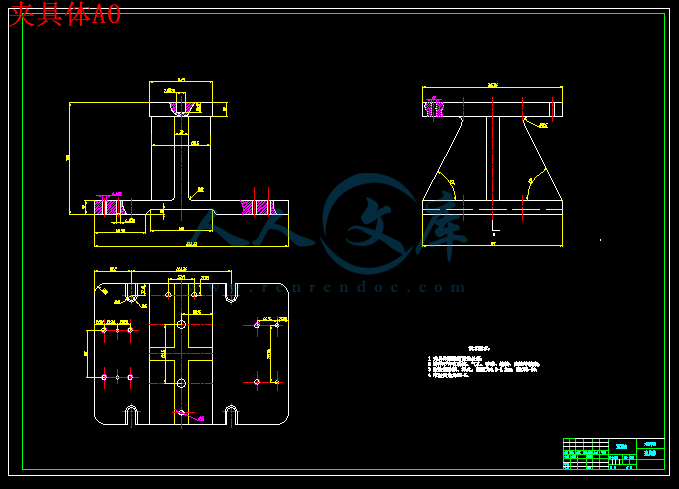摘 要
机械制造技术基础课程设计是我们在学完了大学的全部基础课、专业基础课以及专业课后进行的。这是我们在进行毕业设计之前对所学的各科课程一次深入的综合性总复习,也是一次理论联系实际的训练。因此,他在我们的大学四年生活中占有重要的地位。
我这次的课题是镗销孔活塞零件专用夹具的设计,有活塞零件图、毛坯图、夹具装配图、夹具零件图各一张以及非标零件图五张,机械加工工艺过程卡片和与所设计夹具对应那道工序的工序卡若干张。首先我们要熟悉零件,题目所给的零件是汽车活塞。了解了活塞的作用,接下来根据零件的性质和零件图上各端面的粗糙度确定毛坯的尺寸和机械加工余量。然后我们再根据定位基准先确定精基准,后确定粗基准,最后拟定活塞的工艺路线图,制定该工件的夹紧方案,画出夹具装配图。
就我个人而言,我希望通过这次课程设计对自己未来将从事的工作进一步适应性的训练,希望自己在设计中能锻炼自己的分析问题、解决问题、查资料的能力 ,为以后的工作打下良好的基础。
由于能力有限,设计尚有很多不足之处,希望各位老师给予指导。
关键词:夹具;活塞;零件图;
Abstract
Machinofacture technology curriculum design is that we mimic all basic courses , technology basic course and major part having completed university being in progress after the specialized course. This is that we always review before the graduation practice being in progress to what be learned every thorough comprehensiveness of course,be also that a theory contacts actual training , it occupies important position therefore, in our university for four years life.
Abstract with the pin hole boring piston parts special fixture design, piston parts diagram, blank map,jig assembly drawing, fixture parts each piece and non-standard parts of figure five. Machining process with the card and the corresponding fixture designed by the procedures of the process of several card. First of all, we must familiar with the parts, subject to the parts is piston understanding of the role, followed in accordance with the nature of parts and components in the face of the map on the roughness of rough determine the size and mechanical Jiagongyuliang. According to another location and then we set the benchmark fine first base, established after the benchmark crude, piston finalizing the road map process, the enactment of the workpiece clamping programme, to draw fixture assembly.
For me personally, I hope that through the curriculum design of their future will be further engaged in the work of adaptive training, in the hope that their design can exercise their own analysis, problem solving, the ability to search information, the work laid for the future A good foundation.
Because of limited capacity, there are a lot of design deficiencies, I hope that teachers give guidance.
Key words:fixture;piston;part drawing;
目 录
年 月 日II
摘 要III
AbstractIV
1绪 论1
1.1 本课题的研究内容和意义1
1.2 国内外的发展概况1
1.3 本课题应达到的要求1
2零件的分析2
2.1 活塞的作用2
2.2 活塞的结构组成2
2.3 活塞的主要技术条件分析3
3 零件的工艺规程设计4
3.1确定零件的生产纲领4
3.2 确定毛坯的材料和制造形式4
3.2.1 毛坯的材料选择4
3.2.2 毛坯的制造方法4
3.3 定位基准的选择4
3.3.1 粗基准的选择5
3.3.2 精基准的选择5
3.4 制定工艺路线6
3.5 活塞毛坯尺寸、加工余量、工序尺寸的确定8
3.5.1 活塞毛坯尺寸的确定8
3.6确定切削用量及工时定额9
3.6.5 止口的切削用量16
4.1 机床夹具的作用及组成18
4.2 机床夹具设计过程18
4.3 夹具的初步设计方案18
4.4定位方案设计19
4.4.1 定位元件选择19
4.4.2 定位误差的分析与计算19
4.4.3 液压缸的设计20
4.5夹紧方案设计21
4.5.1 夹紧元件的选取21
4.5.2 夹紧力的分析与计算22
4.5.3 原动力计算22
5 结论与展望24
5.1 结论24
5.2 不足之处及未来展望24
致 谢25
参考文献26
1绪 论
1.1 本课题的研究内容和意义
工艺工装毕业设计是在机械制造工艺学及机床夹具等课程的基础上,进行生产实习基础上进行的一个重要环节,它要求学生全面地综合运用本课程及有关选修课程的理论和实践知识,进行零件加工工艺规程设计和机床夹具设计。
工具的制造对人类的影响是极其巨大。从某种程度上说,工具的先进水平决定着生产力的高低也是伴随着劳动工具的发展与变革。制造业是任何一个发达国家的基础工业,是一个国家综合国力的重要体现。然而在制造业中,夹具工业又是制造业的基础,得到了各个国家的高度重视。尤其在今天以知识为驱动的全球化经济浪潮中,由于激烈的市场竞争,夹具工业的内涵、深度和广度都发生着深刻变化,各种新的夹具设计、制造加工方法不断的出现,推动我们社会的不断向前发展。
1.2 国内外的发展概况
夹具工业是现代工业的基础。它的技术水平在很大程度上决定了产品的质量和市场的竞争力,在如此严峻的行业背景下,我国的技术人员经过不断地改革和创新使得我国的模具水平有了较大的提高。大型、复杂、精密、高效和长寿命的夹具又上了新的台阶。夹具是每个机制制造方面目前普遍用的,它可以大批量生产,节省人力物资,效率相对高,操作方便,结构合理,它的成本低廉,适合广大人群所承受的能力。
通过课程设计的准备工作,进一步提高我们独立调研能力以及专业的业务素质。并通过文献查阅,现场收集资料等工作锻炼解决夹具工程技术的问题的能力;能巩固深化扩充我们的专业知识,并通过课程设计中对涉及到的问题的分析研究,提出我们自己的见解和观点;通过课程设计,树立良好的工作思想和细致、严谨、科学的工作态度,为将来成为一个未来的工程师奠定良好的基础。
1.3 本课题应达到的要求
这次设计使我能综合运用机械制造工艺学中的基本理论,并结合生产实习中学到的实践经验和知识,独立的分析和解决工艺问题,初步具备了设计一个中等复杂程度零件的工艺规程的能力和运用夹具设计的基本原理和方法,拟订夹具设计方案,完成夹具结构设计的能力,为未来从事的工作打下良好的基础。
由于能力有限,设计尚有很多不足之处,希望各位老师给予指导。




 川公网安备: 51019002004831号
川公网安备: 51019002004831号